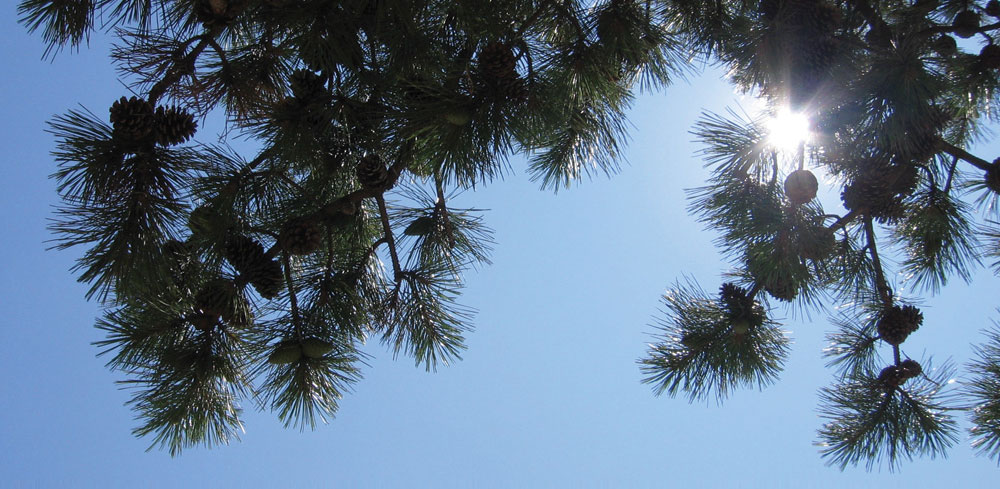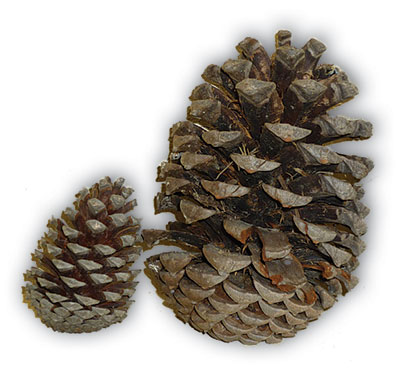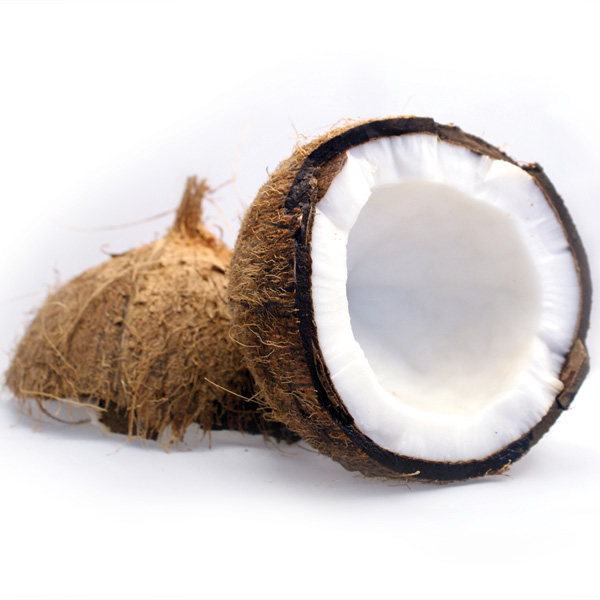By Pauline James

Pine cones of all shapes and sizes make great natural treats or playthings for parrots, and apart from a little time spent collecting and cleaning them, they cost nothing! The cone’s multiple woody scales make them easy to hold and manipulate, and as a bonus, each one contains an edible seed, safe for parrots. But, even if not appreciated as a food, parrots just love rolling, chasing, chewing and tearing pine cones apart!
The best time to collect pine cones, typically from spruce or pine trees, is generally in early autumn. It is important to gather them as soon as possible after they have fallen to the ground, and before the October rains arrive. Cones need plenty of rain, to grow and develop on the tree, but once they have fallen to the ground, attract fungal and moss spores, harmful bacteria and insects, if they get rained on, day after day.
Go prepared with a bucket or plastic shopping bag, as pine cones often exude a sticky sap, and cotton bags or wicker baskets can get spoilt. Select only the youngest, firmest, lightest-coloured and driest cones, and avoid those that are wet, slimy, or sticky, or show signs of mould or mossy growths.
Once home, cones can be soaked, washed, and rinsed to get rid of any excess sap, invisible spores, or insects, particularly earwigs hiding inside, or baked in the oven, to render them parrot-safe.
 To wash, empty cones into the kitchen sink and cover with warm water, anti-bacterial liquid soap and a little avian disinfectant, and leave to soak for 45 minutes. Then, thoroughly rinse each cone under the running tap, if any remain sticky, repeat the process. Once clean, lay the cones out, and leave to dry naturally in the sun.
To wash, empty cones into the kitchen sink and cover with warm water, anti-bacterial liquid soap and a little avian disinfectant, and leave to soak for 45 minutes. Then, thoroughly rinse each cone under the running tap, if any remain sticky, repeat the process. Once clean, lay the cones out, and leave to dry naturally in the sun.
For the second ‘cleaning’ option, line your largest baking trays with tin foil (to protect them from the sap) and place in an oven pre-heated to 200°C. Bake for 20 minutes, or until the sap has dried-out and lost its stickiness. Keep an eye on them, and don’t raise the temperature further, otherwise they may scorch, or even catch fire! Then, turn the oven off, leaving the cones insitu for a further two hours, to thoroughly dry out and cool.
Very often it is the simplest things that parrots love the most, and natural pine cones, accessible to everyone, are guaranteed to keep them amused for ages!
A good alternative to cow’s milk?
By Pauline James
Cow’s milk in theory is a good medium to provide protein, vitamin D, calcium and to soften foods such as wholegrain bread in order to make it more nourishing and easier to eat for parrots. Bread soaked in milk was often fed as a rearing food before the introduction of eggfoods and some breeders still feed it. But in practice, the amount birds consume should be strictly limited as they cannot digest cow’s milk as readily as humans. So, what about coconut milk?
What is coconut milk?
Coconut milk is not the juice found inside a coconut, but is the diluted cream pressed out of the thick, white flesh of a well-matured coconut. Good quality coconut milk is pure white in colour and tastes rich, creamy and mildly sweet with the essence of coconut. It should have a complexity and depth of flavour to it, and leave no unpleasant aftertaste. The colour and its rich taste can be attributed to its high oil content. Even though pre-packed pure coconut milk sold in supermarkets is not fresh, and nutritionally not as good as fresh coconut milk, it is still an excellent and nourishing food. It is the perfect dairy-free alternative to cow’s milk, and lacks the lactose which bird’s find difficult to digest. Powdered coconut milk or the waxy condensed blocks that require blending with water are inferior products and not recommended.
Even though pre-packed pure coconut milk sold in supermarkets is not fresh, and nutritionally not as good as fresh coconut milk, it is still an excellent and nourishing food. It is the perfect dairy-free alternative to cow’s milk, and lacks the lactose which bird’s find difficult to digest. Powdered coconut milk or the waxy condensed blocks that require blending with water are inferior products and not recommended.
Only good saturated fats
Coconut milk contains a high level of good saturated fatty acids and medium-chain triglycerides (MCT), which do not require bile acids for digestion and are easily metabolised and burnt off by the body. MCTs are therefore beneficial in helping to control weight gain, a problem often attributed to sedentary companion birds.
Coconut milk is a rich source of manganese, copper, potassium, phosphorus, dietary fibre and selenium, an important antioxidant which helps to relieve the symptoms of arthritis. In addition it also contains calcium, vitamin B1, B3, B5, B6, folate, vitamin C and E, and protein. In fact it is such a nutrient-rich food that Johannes van Overbeek discovered back in 1943, that coconut milk could actively encourage plant growth, and when coconut milk made up 10 per cent of the substrate growing wheat, there was a substantial improvement in yield.
Used in the treatment of AIDS
There are two grades of coconut milk, thick and thin. Thick milk or coconut cream is the result of squeezing grated coconut flesh using specialised machinery. The squeezed pulp is then soaked in warm water and squeezed a second or third time to achieve thin coconut milk. Manufacturers of coconut milk typically combine the thin milk with the cream and water to make the final product, but some brands are of a much higher quality than others.
This milk has the advantage of also being cholesterol-free, with most of its saturated fat content being lauric acid. This saturated fatty acid is found in abundance in human breast milk, but only 3-4 per cent is found in goat’s milk and even less in cow’s milk. It is important in producing good cholesterol and creating a more favourable blood cholesterol profile, helping to support a healthy cardiovascular system.
This milk also has important antimicrobial properties to aid the digestive system, is anti-carcinogenic (reducing the risk of cancers) and anti-pathogenic (reducing the risk of disease). The potent antiviral, antifungal and antimicrobial effects of coconut oil are used in the treatment of Candida, and more recently in the fight against AIDS.
Avoid buying tins...
Fresh coconut milk is rare outside the tropics and most consumers buy it in cartons, bottles or cans. Opt for cartons or bottles, as buying milk in tins has a question mark over it. Bisphenol A (BPA) used in the manufacture of the can lining can leach into foods which are acidic, salty or fatty, and coconut milk contains fat.
BPA is an organic compound used to make polycarbonate polymers, epoxy resins and plastics, and is controversial because it exerts weak, but detectable, hormone-like properties. This raises concerns about its presence in food packaging and the potential damage exposure could do to foetuses, infants and young children.
Make your own
Coconut milk can also be made at home, with coconut flakes or shredded coconut, a blender and cheesecloth. Steeping the coconut in hot water will soften it, and extract the oil and aromatic compounds. When cool, place it in a liquidiser or blender and then filter the liquid through the cheesecloth. This milk, with a fat content of 17 per cent, like all other natural milks which have not been artificially homogenized, separates when refrigerated, with the thicker natural coconut cream rising and setting at the top.
Coconut cream can also be purchased and blended with water to make coconut milk. Making up small quantities of your own milk can be advantageous, as once a carton of coconut milk is opened even when refrigerated, only lasts for a few days, and does not tend to freeze well.

 To wash, empty cones into the kitchen sink and cover with warm water, anti-bacterial liquid soap and a little avian disinfectant, and leave to soak for 45 minutes. Then, thoroughly rinse each cone under the running tap, if any remain sticky, repeat the process. Once clean, lay the cones out, and leave to dry naturally in the sun.
To wash, empty cones into the kitchen sink and cover with warm water, anti-bacterial liquid soap and a little avian disinfectant, and leave to soak for 45 minutes. Then, thoroughly rinse each cone under the running tap, if any remain sticky, repeat the process. Once clean, lay the cones out, and leave to dry naturally in the sun.

 Even though pre-packed pure coconut milk sold in supermarkets is not fresh, and nutritionally not as good as fresh coconut milk, it is still an excellent and nourishing food. It is the perfect dairy-free alternative to cow’s milk, and lacks the lactose which bird’s find difficult to digest. Powdered coconut milk or the waxy condensed blocks that require blending with water are inferior products and not recommended.
Even though pre-packed pure coconut milk sold in supermarkets is not fresh, and nutritionally not as good as fresh coconut milk, it is still an excellent and nourishing food. It is the perfect dairy-free alternative to cow’s milk, and lacks the lactose which bird’s find difficult to digest. Powdered coconut milk or the waxy condensed blocks that require blending with water are inferior products and not recommended.